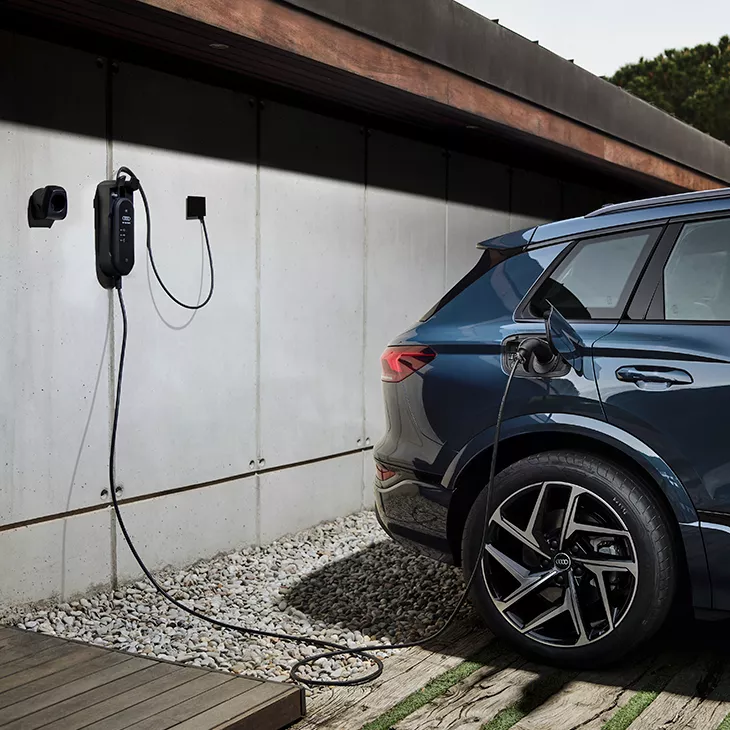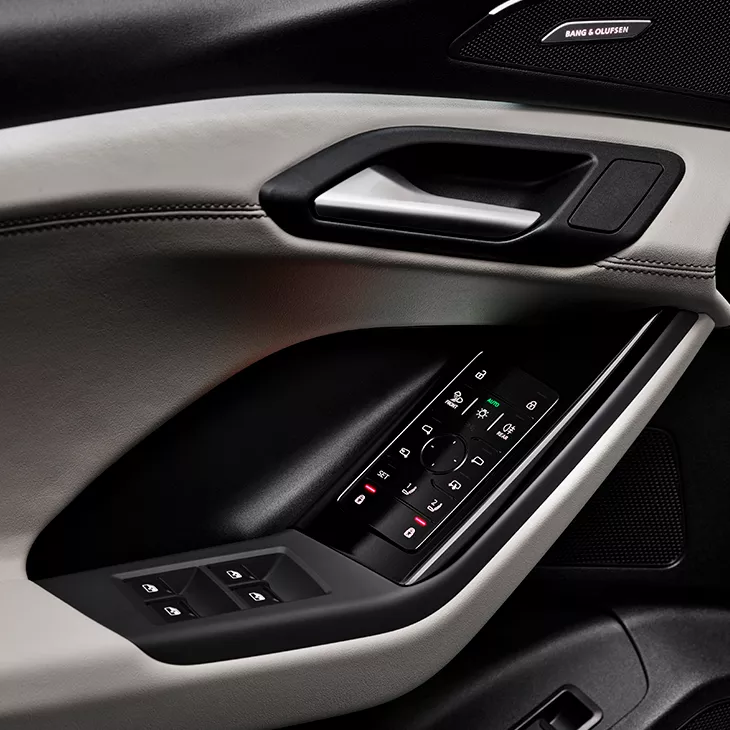Experience Vorsprung durch Technik: the new Audi Q6 e-tron
• The new Audi Q6 e-tron sets standards in terms of performance, range, charging, driving dynamics and design
• The new model takes the digital experience at Audi to a new level
• The Q6 e-tron is under consideration for the South African market
March 2024, Ingolstadt –The new Audi Q6 e-tron is the first production model on the Premium Platform Electric (PPE), marking the next step in the company’s transformation into a provider of premium electric mobility. The model is defined not only by impressive driving and charging performance, but also by increased efficiency and long range.
The Audi Q6 e-tron embodies typical Audi SUV styling with a further refined e-tron design language. The new design philosophy in the interior and pioneering technologies debuting in the new model, begin the next chapter in electric mobility for the Four Rings and make Vorsprung durch Technik a tangible experience every day. With the Q6 e-tron range, e-mobility is coming from the Ingolstadt plant for the first time.The PPE, developed jointly with Porsche, and the E3 1.2 electronic architecture are important milestones in the expansion of Audi's global range of electrically powered models. They mark the start of a comprehensive strengthening and rejuvenation of the model portfolio. The Q6 e‑tron underpins Audi’s promise to offer electric vehicles in all core segments by 2027.
The state-of-charge (SoC) increases from 10 to 80 percent in around 21 minutes. Intelligent, high-performance, and predictive thermal management is a key component of this impressive charging performance. Equipped with Plug & Charge, the vehicle authorises itself at compatible charging stations when the charging cable is plugged in and commences the charging process. Charging is also fully automatic. If a charging station works with 400‑volt technology, the Audi Q6 e-tron can, for the first time, enable bank charging. The 800‑volt battery is automatically divided into two batteries at equal voltage, which can then be charged in parallel with up to 135 kW. Depending on the state of charge, both halves of the battery are first equalised and then charged simultaneously. AC charging with up to 11 kW is possible at standard home chargers.An important component in increasing the efficiency and therefore the range of the Audi Q6 e-tron is the advanced recuperation system. Around 95 percent of all everyday braking processes can be handled by this system. The Audi Q6 e-tron recuperates at up to 220 kW.
The upright front features a completely closed Singleframe and a mask in selenite silver or gloss black, which surrounds the three-dimensionally shaped Singleframe and the side air intakes. The high-positioned digital daytime running lights give the Q6 e-tron a very distinctive and independent appearance.The greenhouse is stretched low and taut over the powerful body. It is slightly tapered towards the rear and the gently sloping D‑pillars flow elegantly into the bodywork’s muscular shoulders. The opening between the D‑pillar and the roof gives the vehicle a more dynamic appearance and makes the cabin appear more stretched and longer. A prominent line running from the rear lights to the rear doors emphasises the upper section of the “quattro blisters” – the contours of the body on which the gently sloping D‑pillars are supported. The blisters are a core element of Audi's design DNA. Audi calls this central design principle "making technology visible". The dynamically tightened rear creates a mixture of sporty elegance and masculine power. The clean and broad rear architecture with its continuous light strip lends the Q6 e‑tron quattro the clarity and aplomb typical of Audi.
With the second generation of digital OLED rear lights, the Audi Q6 e-tron takes lighting design, functionality and therefore road safety to a new level. For the first time, the digital OLED rear lights can communicate with the vehicle’s surroundings in a targeted manner (Car‑to‑X). Audi has also taken the safety functions to a new level. The proximity detection system already known from other Audi models has been extended in the new Q6 e-tron to include the communication light. It warns other road users of accident and breakdown sites. In addition to the regular taillight graphics, the communication light displays a specific static taillight signature with integrated warning symbols in the digital OLED combination rear light in critical driving or traffic situations.
The technology, which is debuting in the Audi Q6 e-tron, also sets new standards in terms of individualisation: With a total of up to eight digital light signatures in the redesigned daytime running lights of the Matrix LED headlights and in the digital OLED rear lights 2.0, owners can individualise their Q6 e-tron in a completely new way.
The materials used were selected from a functional point of view and at the same time ensure a clear design differentiation between the various vehicle areas in the interior. Comfort-oriented areas are designed with generous surfaces and soft materials. In contrast, the precisely designed control areas in high-quality high-gloss black emphasise the clarity of interaction with the vehicle. Thanks to the new PPE, which was developed specifically for e-mobility, the vehicle has a generous feeling of space and roominess as well as a high level of everyday practicality. The interior offers plenty of storage space and compartments. The increased comfort of the middle seat in the rear is typical of an electric car with a long wheelbase (2,899 millimetres) and lacking a central tunnel. The trunk offers 526 litres of storage space. If the rear seat bench is folded down, the storage space increases to up to 1,529 litres.
The rear seats can be folded down separately (40:20:40). A further 64 litres of storage are available in the frunk (front trunk) under the front hood – a convenient place to stow smaller travel bags, for example. As a result, the Audi Q6 e-tron offers sufficient space for five passengers and their luggage. With its high utility value, it fulfils the requirements that customers place on an Audi SUV.
In addition, the E3 1.2 is characterised by a high-performance and seamless backend connection for Car-to-X swarm data applications and computationally intensive offboard functions. It is debuting in the Audi Q6 e-tron, designed to be used across models, and forms the basis for future innovations.
With the optional Augmented Reality Head-Up Display, another central element of the digital stage, Audi is taking a major step forward in display technology. It reflects a large, tilted image plane across the windshield towards the driver and shows relevant information such as speed, traffic signs, assistance, and navigation symbols. The image plane is tilted forwards to enhance the augmented reality impression. The focus of the human eye moves with it. This process and the far virtual distance of the image create the impression that the elements shown are floating up to 200 metres away. Virtual content is thus seamlessly integrated into reality. The information can be understood quickly without irritating or distracting the person driving. The field of view of the augmented reality function corresponds to a diagonal of around 88 inches viewed from the driver's position.
Audi's self-learning voice assistant, the Audi Assistant, can be used to control numerous vehicle functions. The digital assistant with AI support is deeply integrated into the vehicle and, for the first time, is displayed using an avatar in the central touch display of the MMI and in the augmented reality head-up display. The new voice assistant understands more than 800 voice commands. It can also be activated via various touchpoints and via the myAudi app, for example. The voice assistant learns continuously based on user behaviour and thus provides support to the person driving. This support can be grouped into three categories: proactive suggestions (context information is used to proactively suggest functions for activation based on this data), smart routines (automatically recognizes recurring operating sequences, such as using the seat climate control from certain outside temperatures) and intelligent lists (such as call lists). The spoken commands are also shown on the display (see-what-you-speak principle). The assistant constantly learns from user behaviour and thus supports the driver.
The rear-biased torque distribution as part of a highly variable all-wheel drive system also enhances the dynamic driving characteristics of the Q6 e-tron. The different dimensions of the electric motors on the rear and front axles enable rear-biased torque distribution even under full load. To complement the rear-biased weight distribution as well as to ensure even more grip and driving dynamics, the rear tyres of the Q6 e-tron are wider than those at the front.
[Note to editors: the Q6 e-tron is under consideration for a South African introduction in Q4 2024 or Q1 2025.]








